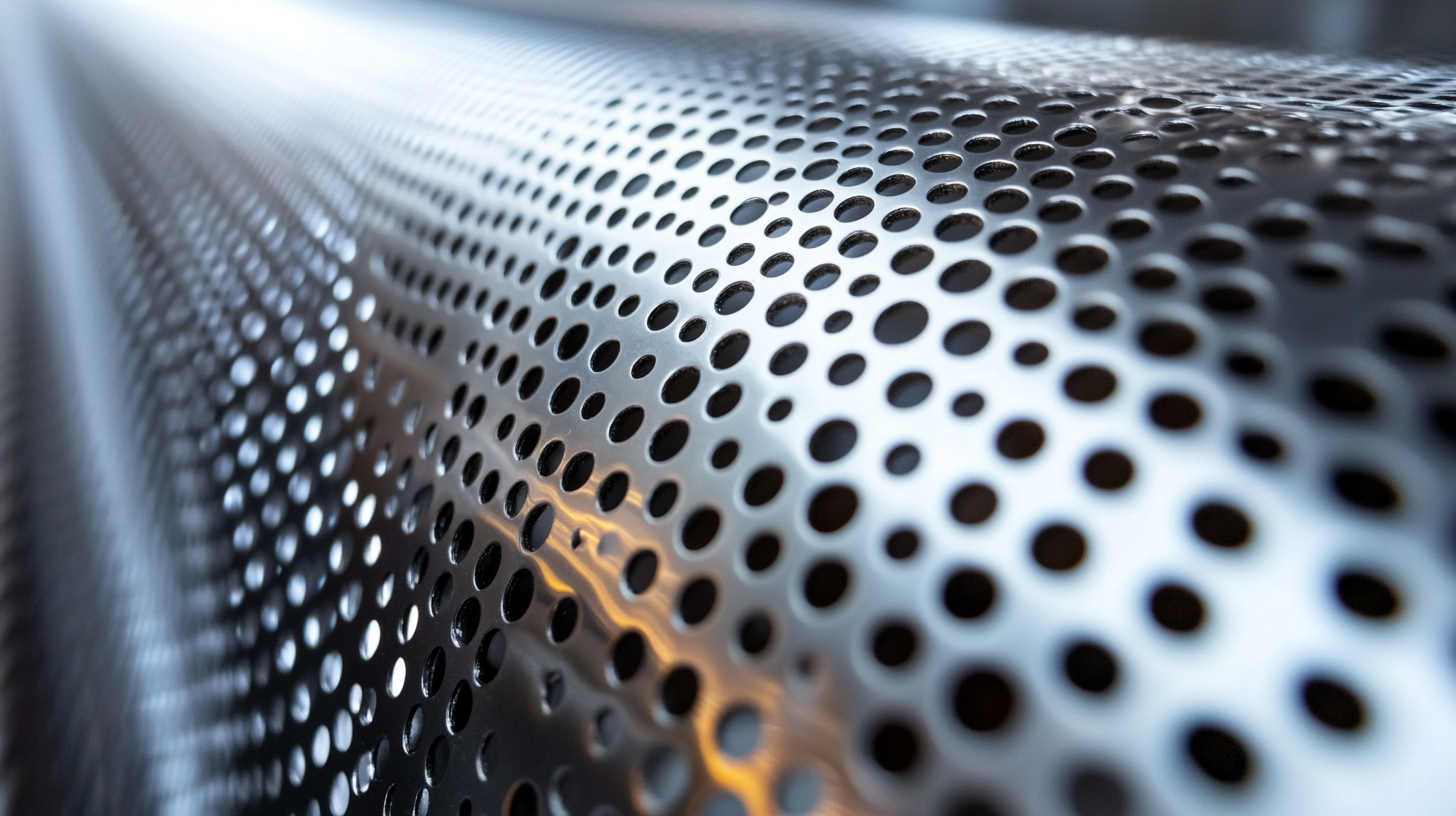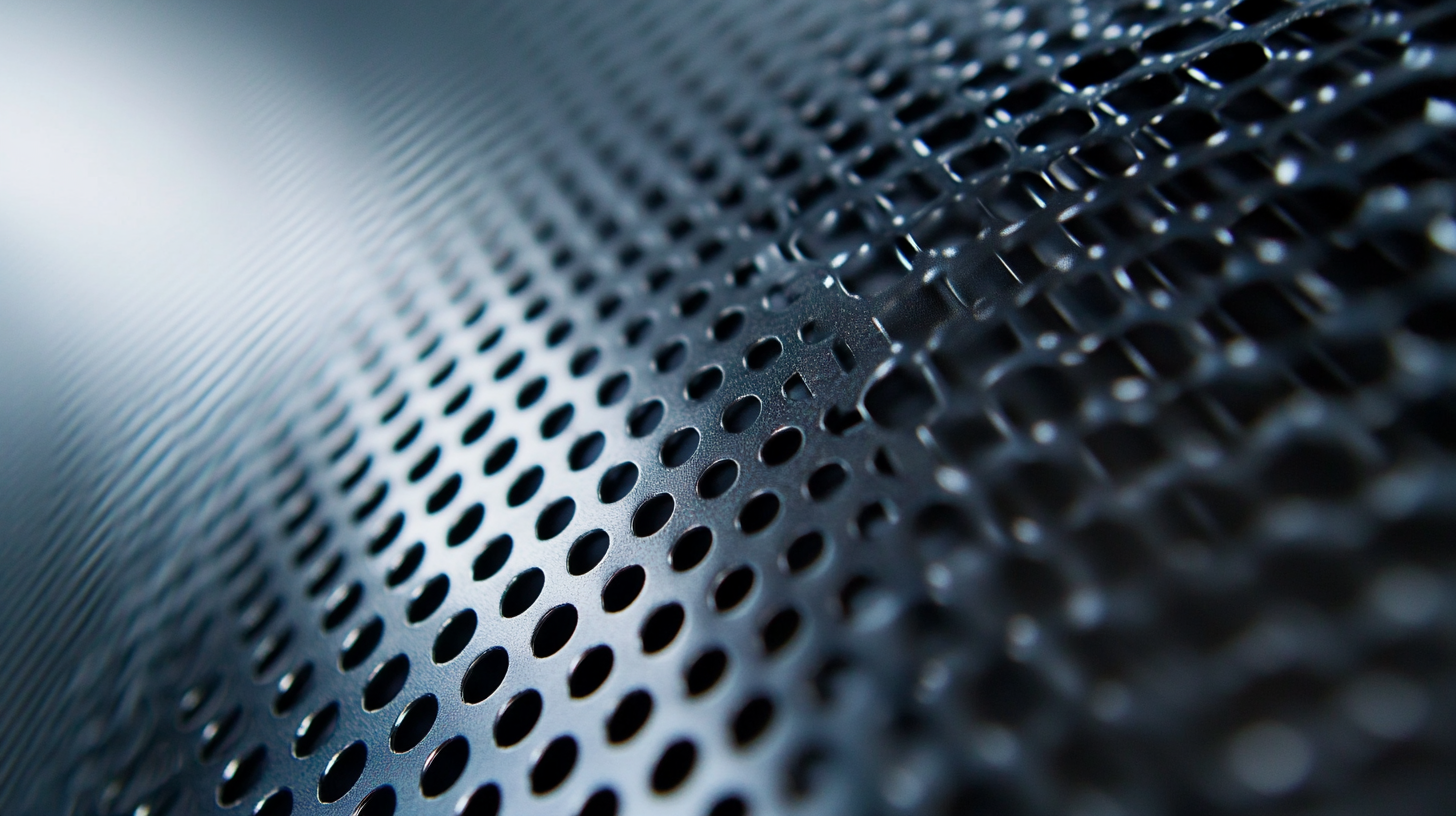 In the evolving landscape of
industrial materials,
Perforated Mesh Sheets have emerged as a crucial component across various applications, from architectural facades to filtration systems.
According to a recent market research report by Grand View Research, the
perforated metal market is projected to reach USD 3.61 billion by 2025, driven by an increasing demand for efficient and durable construction materials.
These sheets, characterized by their unique patterns and holes, not only provide aesthetic appeal but also enhance functionality by allowing for air, light, and liquid flow.
As industries strive for sustainability and efficiency, understanding the best perforated mesh sheets and their standards is imperative. This blog will delve into the current trends reshaping the industry in 2025 and explore innovative solutions that address the growing needs for performance, safety, and environmental responsibility.
In the evolving landscape of
industrial materials,
Perforated Mesh Sheets have emerged as a crucial component across various applications, from architectural facades to filtration systems.
According to a recent market research report by Grand View Research, the
perforated metal market is projected to reach USD 3.61 billion by 2025, driven by an increasing demand for efficient and durable construction materials.
These sheets, characterized by their unique patterns and holes, not only provide aesthetic appeal but also enhance functionality by allowing for air, light, and liquid flow.
As industries strive for sustainability and efficiency, understanding the best perforated mesh sheets and their standards is imperative. This blog will delve into the current trends reshaping the industry in 2025 and explore innovative solutions that address the growing needs for performance, safety, and environmental responsibility.
When selecting high-quality perforated mesh sheets, several key characteristics must be considered to ensure optimal performance across various applications. Firstly, the material quality plays a significant role; stainless steel and aluminum are often favored for their durability and resistance to corrosion. These materials not only enhance the longevity of perforated sheets but also ensure they maintain structural integrity under varying environmental conditions.
In addition to material quality, the pattern and size of the perforations are crucial. Different applications require different airflow and drainage capabilities, which are directly influenced by the hole diameter and spacing. For example, finer perforations may be suitable for filtration purposes, while larger holes are ideal for applications requiring maximum airflow, such as in sound attenuation panels. Understanding these nuances allows manufacturers and users to choose the ideal mesh for their specific needs, ultimately leading to improved efficiency and performance in their applications.
In the production of perforated mesh sheets, industry standards play a critical role in ensuring quality and consistency across various applications. These standards define the specifications for hole sizes, material thickness, and overall sheet dimensions, which are crucial for meeting the specific needs of industries such as construction, automotive, and aesthetic design. By adhering to established benchmarks, manufacturers can guarantee that their products not only perform effectively but also comply with safety regulations, thereby reducing liability and enhancing customer trust.
Moreover, the establishment of industry standards fosters innovation and efficiency within the manufacturing process. When companies abide by recognized guidelines, they can streamline their production methods, reduce waste, and implement best practices that lead to better design outcomes. This interconnectedness not only benefits the manufacturers by enhancing productivity but also ensures that end-users receive high-quality products suited to their precise requirements. Ultimately, understanding and adhering to these industry standards is essential for maintaining a competitive edge in the ever-evolving market of perforated mesh sheets.

When it comes to crafting durable perforated mesh sheets, material selection plays a crucial role in determining the product's longevity and performance. Various materials exhibit unique properties that can significantly impact the final product’s effectiveness in diverse applications. For instance, aluminium is increasingly favored due to its ability to support intricate architectural designs, owing to its lightweight yet sturdy composition. This quality makes aluminium perforated sheets a go-to choice for architects and builders looking to combine functionality with aesthetic appeal.
Moreover, the ongoing advancements in sheet materials reveal a trend towards more robust and sustainable options. While traditional materials like plywood and MDF continue to be popular, emerging alternatives such as PET panels are being scrutinized for their environmental impact. By understanding the characteristics and benefits of different materials, designers and builders can ensure that their perforated mesh sheets not only meet industry standards but also fulfill specific project requirements, incorporating both durability and design flexibility in their constructions.
| Material Type | Thickness (mm) | Hole Diameter (mm) | Open Area (% Effective) | Applications |
|---|---|---|---|---|
| Stainless Steel | 1.0 | 5.0 | 55 | Architecture, Filtration |
| Aluminum | 1.5 | 3.0 | 60 | Industrial Applications |
| Copper | 2.0 | 4.0 | 50 | Electrical Components |
| Plastic | 0.8 | 8.0 | 65 | HVAC, Home Décor |
| Carbon Steel | 1.2 | 6.0 | 52 | Construction, Fencing |
When it comes to evaluating the performance of perforated mesh sheets, several metrics and testing methods are crucial for ensuring quality and efficiency. Industry reports indicate that the aperture size, hole shape, and perforation pattern can significantly influence airflow, filtration efficiency, and structural strength. For instance, a study by the American Society of Mechanical Engineers highlights that mesh sheets with a circular hole pattern offer 15% more airflow compared to square holes, making them preferable in applications like HVAC systems.
To effectively test these sheets, companies often employ methods such as airflow tests, tensile strength assessments, and chemical resistance evaluations. These tests provide concrete data that can guide manufacturers and consumers in selecting the right perforated mesh for their needs. According to the International Organization for Standardization (ISO), adherence to standardized testing protocols can enhance reliability and performance consistency, helping businesses meet industry benchmarks.
Tip: When selecting a perforated mesh sheet, prioritize those with certified testing results to ensure compliance with industry standards. Additionally, consider the specific requirements of your application—whether it's load-bearing capacity or air circulation—to make an informed choice that enhances performance and durability.
Perforated mesh sheets are becoming increasingly vital across various industries, owing to their unparalleled versatility and efficiency. They find applications in sectors such as automotive, aerospace, and construction, where they enhance structural integrity and promote airflow. Best practices in perforated mesh design ensure that these sheets not only meet industry standards but also cater to specific project requirements, thus boosting overall performance.

For businesses looking to optimize their use of perforated mesh sheets, it's essential to consider material selection and hole patterns. Customizing these aspects can lead to improved strength and reduced weight, crucial factors in sectors like aerospace where performance is paramount. Additionally, integrating advanced technologies, such as 3D modeling software, can streamline the design process, allowing for rapid prototyping and testing.
Tip: Always work closely with material suppliers to understand the latest advancements in perforated mesh. Leveraging their expertise can provide insights into new materials or designs that might enhance your project's outcome. Keeping abreast of trends, such as those driven by generative AI and advanced data analytics, can also guide your design decisions, ensuring that your solutions remain at the forefront of industry standards.
